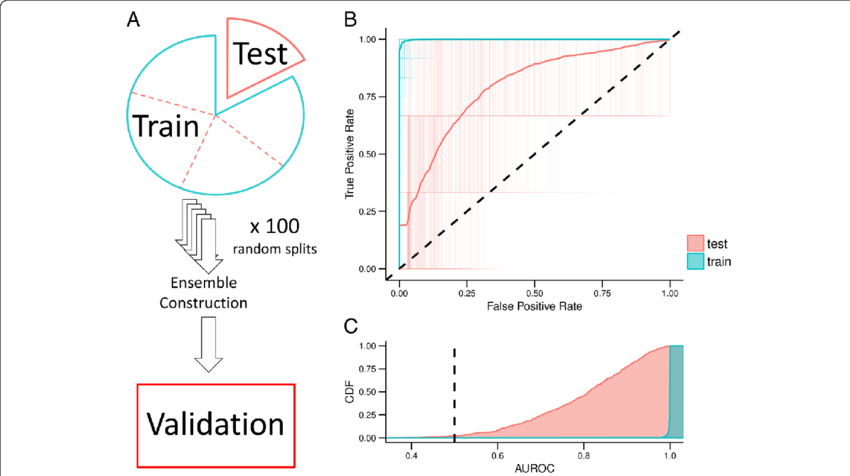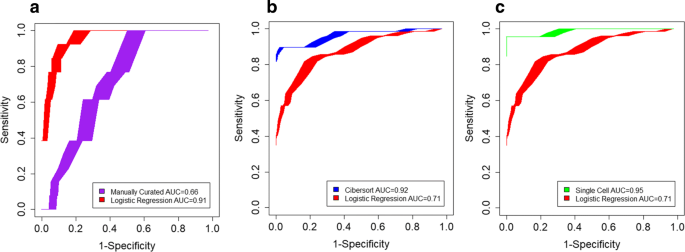Key takeaways
- In the realm of predictive modeling, Elastic Net Logistic Regression is undoubtedly groundbreaking.
- By combining advanced regularization techniques, this method offers a unique balance between feature selection and feature shrinkage, making it ideal for handling complex datasets with multicollinearity issues.
- Apart from selecting relevant features on its own, Elastic Net Logistic Regression performs better in terms of prediction accuracy than standard models.
- Its adaptive regularization features allow it to adapt to different data situations, ensuring consistent and comprehensible results.
- Python libraries such as Stats models and Scikit-learn make the implementation of Elastic Net Logistic Regression straightforward.
- You may leverage Elastic Net’s capabilities to quickly and easily develop predictive models for a range of real-world applications, such as banking and healthcare. marketing and fraud detection.

Introduction
Because The Elastic Net Logistic Regression offers the perfect ratio of shrinkage to feature selection, it is a revolutionary tool in the predictive modeling space. This method gracefully integrates advanced regularization techniques to handle complex datasets, especially those with multicollinearity issues. Not only does Elastic Net Logistic Regression go above and beyond conventional models in performance prediction, but it also accomplishes so by automatically sifting and choosing pertinent data. Its proficiency with adaptive regularization ensures accurate and comprehensible results over a broad spectrum of data conditions. Because of user-friendly libraries like Scikit-learn and Stats models, which let users develop dependable prediction models for a variety of real-world applications, including marketing, fraud detection, healthcare, and finance, Elastic Net is simple to deploy in Python. The future of predictive modeling has arrived, and Elastic Net Logistic Regression is leading the charge.
Understanding the Basics of Logistic Regression
Logistic regression is a statistical modeling technique that is used to predict binary outcomes based on input variables.
It is widely used in many different areas, including as marketing, finance, and healthcare, to investigate the relationship between a set of independent variables and a binary dependent variable.
The goal of logistic regression is to estimate the probability of an event occurring given the values of the input variables.
The logistic function, which transforms any real-valued input into a probability of occurrence value between 0 and 1, is the basis of this system.
Introduction to Elastic Net Regularization
Regularization is a technique used in prediction models to prevent overfitting by adding a penalty term to the loss function.
Elastic Net regularization combines the L1 (Lasso) and L2 (Ridge) regularization techniques to balance feature selection with feature shrinkage.
It is particularly useful when dealing with datasets that are large in features or when the input variables exhibit multicollinearity.
Because Elastic Net regularization can handle both continuous and categorical variables, it is a versatile technique that can be used to a wide range of data types.
Benefits of Elastic Net Logistic Regression
Compared to conventional logistic regression models, Elastic Net Logistic Regression has the following advantages:
1. By lowering the coefficients of unnecessary or irrelevant variables to zero, Elastic Net’s feature selection algorithm automatically selects useful features.
2. Improved predictive performance: Combining L1 and L2 regularization yields better prediction accuracy for Elastic Net than utilizing each technique separately.
3. Adaptive regularization: Because Elastic Net adapts the level of regularization to the data, it can handle a range of multicollinearity and feature importance.
4. Interpretable results: The directionality and significance of the input variables can be determined using the Elastic Net Logistic Regression coefficients.
When everything is said and done, Elastic Net Logistic Regression is a useful technique for developing precise and understandable predictive models.
Implementing Elastic Net Logistic Regression in Python
Numerous Python packages, including Scikit-learn and Statsmodels, offer Elastic Net Logistic Regression implementations.
Use these steps to implement Elastic Net Logistic Regression in Python:
1. Preprocess the data: Address missing values, encode category variables, and scale the numerical features as needed.
2. Split the data: Divide the dataset into training and testing sets in order to evaluate the performance of the model.
3. Explain the model. Create an instance of the Elastic Net CV class and supply the desired regularization parameters.
4. Fit the model: Use the fit() method to train the model with the training set of data.
5. Assess the model: Utilizing the testing data, calculate metrics such as accuracy, precision, and recall to determine the model’s efficacy.
6. Examine the results to determine how the input variables affected the anticipated result by looking at the model’s coefficients.
You may use Elastic Net Logistic Regression’s sophisticated regularization techniques for predictive modeling in Python with ease by following these steps.
Case Studies and Real-World Applications
Numerous fields and real-world situations have seen the successful application of elastic net logistic regression:
1. Healthcare: Predicting the likelihood that an illness would progress through the use of genetic markers, medical history, and patient demographics.
2. Finance: Assessing loan applicants’ creditworthiness by utilizing financial data and credit history information.
3. Marketing: Using demographic information, engagement metrics, and purchase history, churn forecast is made.
4. Fraud detection: Transactional data and behavioral characteristics are used to identify fraudulent transactions.
These case studies demonstrate how flexible and effective Elastic Net Logistic Regression is at handling difficult predictive modeling problems.
Conclusion
In conclusion, Elastic Net Logistic Regression is a state-of-the-art technique for predictive modeling that offers the perfect ratio of feature selection to shrinkage. Because of its powerful regularization methods, this method automatically detects significant variables and increases prediction performance above standard models. The flexible regularization characteristics of Elastic Net Logistic Regression allow it to adjust to different data conditions, ensuring accurate and comprehensible results. This powerful tool may be easily implemented in Python with the help of the Scikit-learn and Stats models packages, enabling users to generate precise predictive models for a range of real-world applications. Future predictive modeling will be able to provide more insightful and precise predictions because to Elastic Net Logistic Regression.

FAQ
What are the advantages of elastic net regularization?
Elastic net regularization provides several important advantages in predictive modeling. First of all, because it strikes a balance between feature selection and feature shrinkage, it is ideal for handling complex datasets with multicollinearity issues. This unique capability ensures that only important features are selected while minimizing the impact of unnecessary or irrelevant variables. Moreover, prediction performance can be improved by Elastic Net regularization, which combines the benefits of L1 (Lasso) and L2 (Ridge) regularization techniques. This leads to better accuracy and generalization than using each technique alone. Another advantage of Elastic Net is its adaptive regularization, which allows it to adjust to different data conditions and varying degrees of multicollinearity and feature relevance. Elastic Net regularization is a useful method that can enhance overall performance. interpretability, and accuracy. of predictive models in a wide range of real-world applications.
How do you choose the optimal values of the regularization parameters for elastic net regression?
Understanding the balance between L1 and L2 penalties is crucial to determining the optimal regularization parameter values for Elastic Net regression. One method to evaluate the model’s performance with vByious regularization parameter values is to use cross-validation techniques, such as k-fold cross-validation. Test a variety of values to determine the regularization parameters that work best for your Elastic Net Logistic Regression model. Then, select the regularization parameter that produces the greatest performance measures, like accuracy or area under the ROC curve. Programs like Elastic Net CV in Python’s Scikit-learn package may automatically search for the optimum hyperparameters using a grid search or randomized search approach, significantly streamlining the process of selecting the appropriate regularization parameter values. You can improve the prediction power by adjusting these parameters. power and generalizability of your Elastic Net model, ensuring robust and reliable results across a variety of data scenarios.
What is the elastic net logistic regression model?
By combining the benefits of L1 (Lasso) and L2 (Ridge) regularization approaches, the state-of-the-art approach known as the elastic net logistic regression model strikes the perfect balance between shrinkage and feature selection. This intelligent model reduces the coefficients of superfluous variables and automatically selects relevant features to ensure the highest anticipated performance across a variety of data circumstances. Its adaptive regularization capabilities, which yield accurate and comprehensible results, make it a useful tool for building trustworthy prediction models. Thanks to user-friendly tools like Scikit-learn and Stats models, the elastic net logistic regression model is simple to implement in Python, allowing users to confidently and precisely take on complex real-world situations.
What is the downside to using Elastic Net regression?
Although Elastic Net Logistic Regression has several advantages, there are drawbacks to use this method as well. A possible disadvantage is the difficulty in evaluating the data. It can be difficult to determine how each individual variable affects the result when L1 and L2 regularization are combined. Furthermore, it might sometimes take a lot of computer power and adjustment to get the ideal values for the regularization parameters, which can be time-consuming. Overfitting could occur if the dataset is too small or if the model is not appropriately tweaked, which is another drawback. Despite these restrictions, Elastic Net Logistic Regression is a useful tool for predictive modeling in a variety of domains since its advantages frequently exceed its disadvantages.
Hope this article was helpful for more checkout our previous blog post by here

